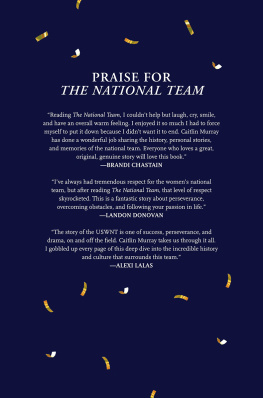On the afternoon of August 1, 1996, more than seventy-six thousand spectators poured into Sanford Stadium on the campus of the University of Georgia in Athens, Georgia. There was nothing unique about that. The University of Georgia football team, the Bulldogs, regularly drew that many fans to each of their home football games every season.
But football wasnt the reason the stadium was full that day. People from all over the world had come to Athens for just one reason. They wanted to see the United States womens soccer team, led by Mia Hamm, play the womens team from the Peoples Republic of China. Millions more were watching on television. At stake that afternoon was an Olympic gold medal the first ever in womens soccer. Never before had so many people gathered to watch a womens sporting event.
Only a few decades earlier, the notion that so many people would watch a soccer game played by women had been inconceivable. Women competed in only a select few sports, such as track and field, golf, tennis, gymnastics, basketball, and figure skating. Many people thought sports like soccer were simply too physically demanding for women to play. Sports were for boys. Girls were supposed to stand on the sidelines and cheer.
Although soccer was the most popular sport in the world and was becoming increasingly popular in the United States as a childrens sport, only a few women in the entire world played competitive soccer. Those that did played in obscurity. Few people even knew that women played soccer. In the United States only a few high schools had a womens soccer team. Not until 1975 did a single college or university have a varsity womens soccer program! There was no such thing as a national team or Womens World Cup competition. No one dreamed that women would someday play soccer in the Olympics.
That was all about to change.
One day in 1973, on the sidelines of a soccer field in Italy, a young American girl sat with her family and watched two teams of Italian boys play soccer. No one in the family understood the game very well, but they still enjoyed watching the two teams race back and forth across the field, controlling the ball with their feet with as much skill and mastery as a basketball player handles the basketball or a hockey player the puck.
The shy young girl, just over a year old and barely able to walk, seemed particularly enthralled. Standing close to her parents, she never took her eyes off the black-and-white soccer ball. Whenever the ball bounded off the field in her direction, she giggled and toddled away from her parents, chasing after it along with other children in the crowd and trying to kick it like the players on the field.
She didnt know that girls werent supposed to play sports. For her, it was fun to chase after the ball and kick it, to run around with other children, then sit and play in the grass together, making friends.
Thats how Mia Hamms soccer career began. Years later, her love of the sport and the friendships she made on the field would take her all over the world.
Mariel Margaret Hamm was born on March 17, 1972, in Selma, Alabama. Her father, William, was a pilot in the United States Air Force, and her mother, Stephanie, was a ballerina. Soon after she was born, her mother started calling her Mia, because the baby reminded her of a ballet teacher with the same name.
As a member of the air force, Bill Hamm was never stationed in one place for very long. In 1973, he was transferred to Italy. The entire family, which then also included an older brother and two older sisters, accompanied Bill to Florence, Italy.
When he wasnt flying airplanes, Bill Hamm loved to watch sports. But in Italy, hardly anyone played the sports Bill watched in the United States, such as baseball and football and basketball. The biggest game in Italy was soccer.
No matter where the family went, it seemed as if a soccer game was being played. In almost every open field or empty street, gangs of young boys raced after a soccer ball. Virtually every town had a mens team, and larger cities often supported several soccer clubs. Most teams were amateur, but the Italians also sponsored several thriving professional leagues. Thousands of fans turned out to support their favorite team, chanting and singing in unison in the stands and waving huge flags and banners. Televised soccer games were the most popular programs in the country.
When Bill started watching soccer, he didnt understand the game very well. Soccer wasnt popular in the United States. Only a few public schools and colleges had soccer teams. There was a professional league, the North American Soccer League, but few people went to the games and they were rarely televised. Only a handful of the players were from the United States. Most were from Europe and South America. In the United States, Bill hadnt paid attention to the game.
But in Italy, he had little choice. If he wanted to watch sports, he had to watch soccer. And the more he watched, the more he began to appreciate the sport. He realized that what had first looked to him like a bunch of players randomly running after a ball was actually a sport that demanded great athletic skill and strategy. He learned that every player on the team played a specific position, just as in basketball or hockey, and had different responsibilities. The more Bill learned about the game, the more he enjoyed it. Soon, he was a rabid soccer fan.
The family loved to do things together, and Bill started taking his family to soccer games. The children, particularly Mia, took to the game immediately. She was small for her age and usually quite shy. But when she saw a soccer ball, her eyes lit up. On the air force base, she often joined other children in impromptu games of soccer.
After only a few years in Italy, Bill was transferred again, this time back to the United States. Although the family left Italy behind, they took their love of soccer with them. They spent a brief period in California, then Bill was sent to Wichita Falls, Texas.
When they arrived there, Bill and Stephanie Hamm were pleased to learn that the community supported a youth soccer program. Little League baseball and other youth sports programs like Pop Warner football were commonplace, but youth soccer programs were still rare in the United States.
Yet ever so slowly, the sport was becoming more and more popular. Unlike many other sports, soccer doesnt require a great deal of equipment. It is relatively safe for children even as young as five or six years old to play. The basics of the game are easy to learn. If you can run and kick a ball, you can play. And one of the best things about soccer is that every player gets to touch the ball.
Because soccer is a sport that relies more on speed and agility than strength and size, soccer is one of the few sports that allows boys and girls to play together. Kids of similar ages, both male and female, are able to compete equally. Actually, since young girls mature faster than boys, girls are often the better players.








